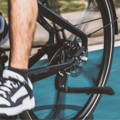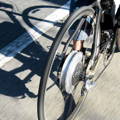In nearly all states, riders do not need a license to operate an electric bike. However, riders of Class 3 e-Bikes in New Jersey need a license, and e-Bike users in Hawaii will need to pay a $30 registration fee.
Can You Upgrade Your E-Bike Motor? What You Need to Know
Written by: Rémy Rossi | June 28, 2025 | Time to read 4 min
Craving more power from your e-Bike? Here’s what’s possible, what’s not, and how to boost performance without breaking the law, or your electric bike.

More about the Author: Remy Rossi
Rémy Rossi is a bike writer, mechanic, and educator who got his start in community-based bike shops and co-ops. With a decade in the industry, he still wrenches on bikes when he can and plays bike polo on a fixie.

🤝 Looking for a sweet deal?
Get an even better discount when you sell your old electric bike!
Click here for a price estimation!
Why upgrade an e-Bike motor?
You may feel that your e-Bike is underpowered— struggling on steep climbs— or you simply want to ride faster. Wattage isn’t everything, however, as high-quality 250W motors can outperform higher powered motors— and pretty much all European electric bikes have 250W motors.
Upgrading just the motor isn’t really the right move anyway. Changes to the battery and the controller are what’s required to unlock more power as they are typically the limiting factors in the equation. It’s probably worth purchasing a whole new or used electric bike with the specs you need, in proper balance as the manufacturer intended.
And rather than upgrading the motor, if your bike didn’t start out with one in the first place, you can still use e-Bike conversion kits to add a boost.

Is it possible to upgrade your e-Bike motor?
Upgrading an e-Bike motor through replacement or post-sale tuning isn’t very common. Most motors aren’t designed for these kinds of changes, meaning you’ll need electrical expertise and specialized tools and you’ll risk damaging the unit and voiding the warranty.
The three ways that the performance of an e-Bike motor could be possibly adjusted include motor tuning, unit replacement, and software updates.
Motor tuning
The complex communication and connections between the battery, controller, and motor determine an e-Bike’s performance. And there are ways to modify, hack, or tune those electronics to unlock additional speed or power. However, this requires advanced electrical knowledge and can be quite complicated, or even impossible, on certain models like mid-drive electric bikes.
Tuning a motor isn’t recommended since it can void the warranty and is often illegal, giving the e-Bike capabilities that go beyond the three class e-Bike system. For example, “jailbreaking” the unit for speeds over 28 mph or 20+ mph with a throttle means the bike isn’t considered an electric bike in most states; rather, it’s subject to the laws regarding motor vehicles like mopeds and motorcycles.
However, there are ways riders can legally fine-tune an e-Bike’s motor via the brand’s compatible app. Apps from Trek, Specialized, Bosch, Aventon, and others allow owners to easily adjust the exact amount of assist for each pedal assist level and access other features related to range, battery, and performance.
Motor replacement

Hub motors are located on either the front or rear wheel and could be easier to replace by only swapping the wheel. However, the new motor would need to be compatible with the existing battery and controller that it connects to.
Motor software update

The most recommended method to upgrade your e-Bike motor is to install the most recent software update. Not all motors receive software updates, but brands like Bosch occasionally release updates that can be downloaded to preexisting motors to improve their performance.
Recently, Bosch released an update for the newer Gen 5 Performance CX motor, increasing the torque levels to 100 Nm. Riders can access this update by visiting their dealer or using the Bosch eBike Flow app. There are also certain accessories, such as displays and battery range extenders, that can be added or retrofitted to your e-Bike to upgrade the setup.
Frequently Asked Questions
Do you need a license for an electric bike?
How much power does an electric bike use?
Studies have shown that e-Bikes with a Bosch drive unit use about 11Wh per mile. This energy consumption translates to an average CO2 emissions amount of around 3.5g per mile. In comparison, a car emits about 240g of CO2 per passenger mile, and public transportation emits 80-176g of CO2 per passenger mile.
Key Takeaways
- Upgrading just the motor isn’t usually feasible— battery and controller limitations make it more complex than a simple swap.
- Tuning your motor is risky and can be illegal, potentially technically reclassifying your e-Bike as a motor vehicle.
- The safest performance boost comes from official software updates or investing in a new e-Bike with the specs you want.


